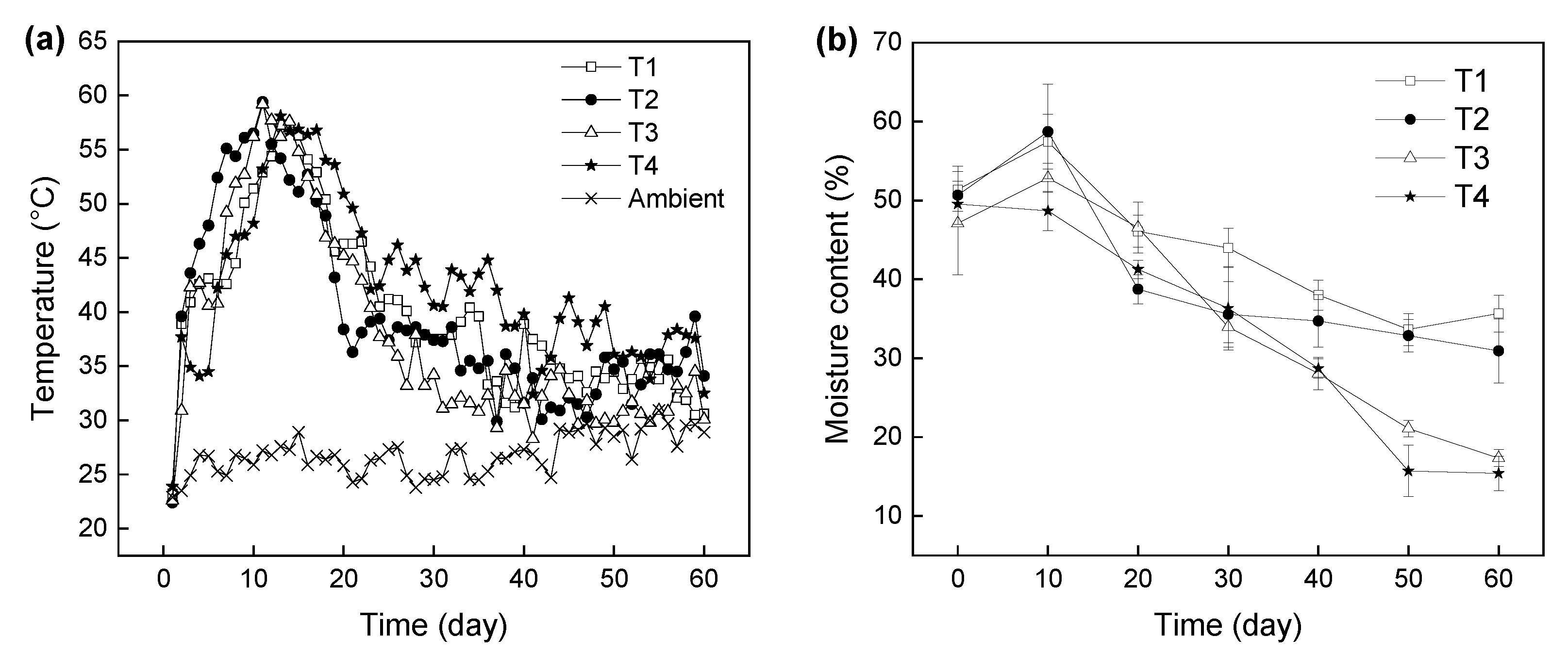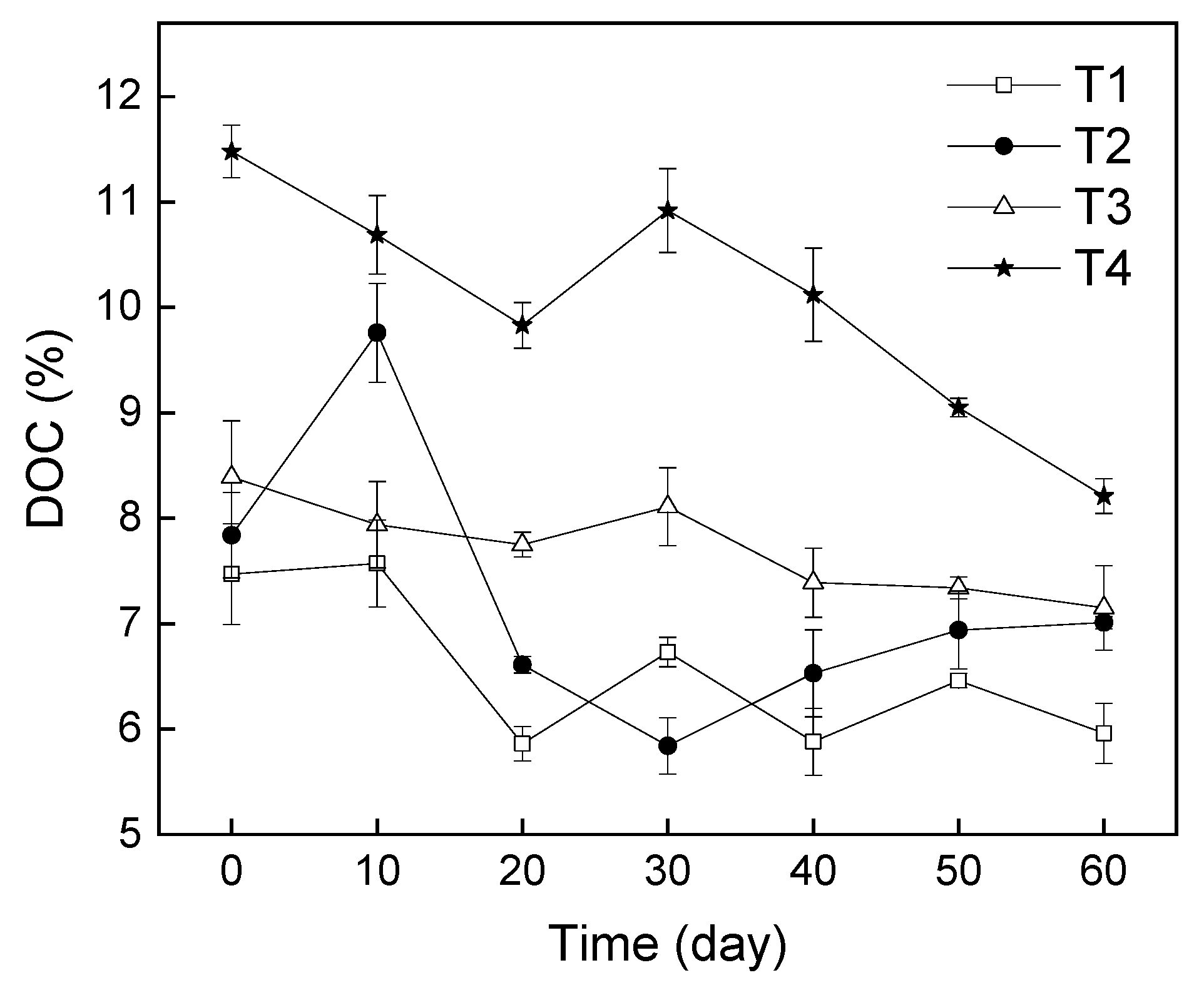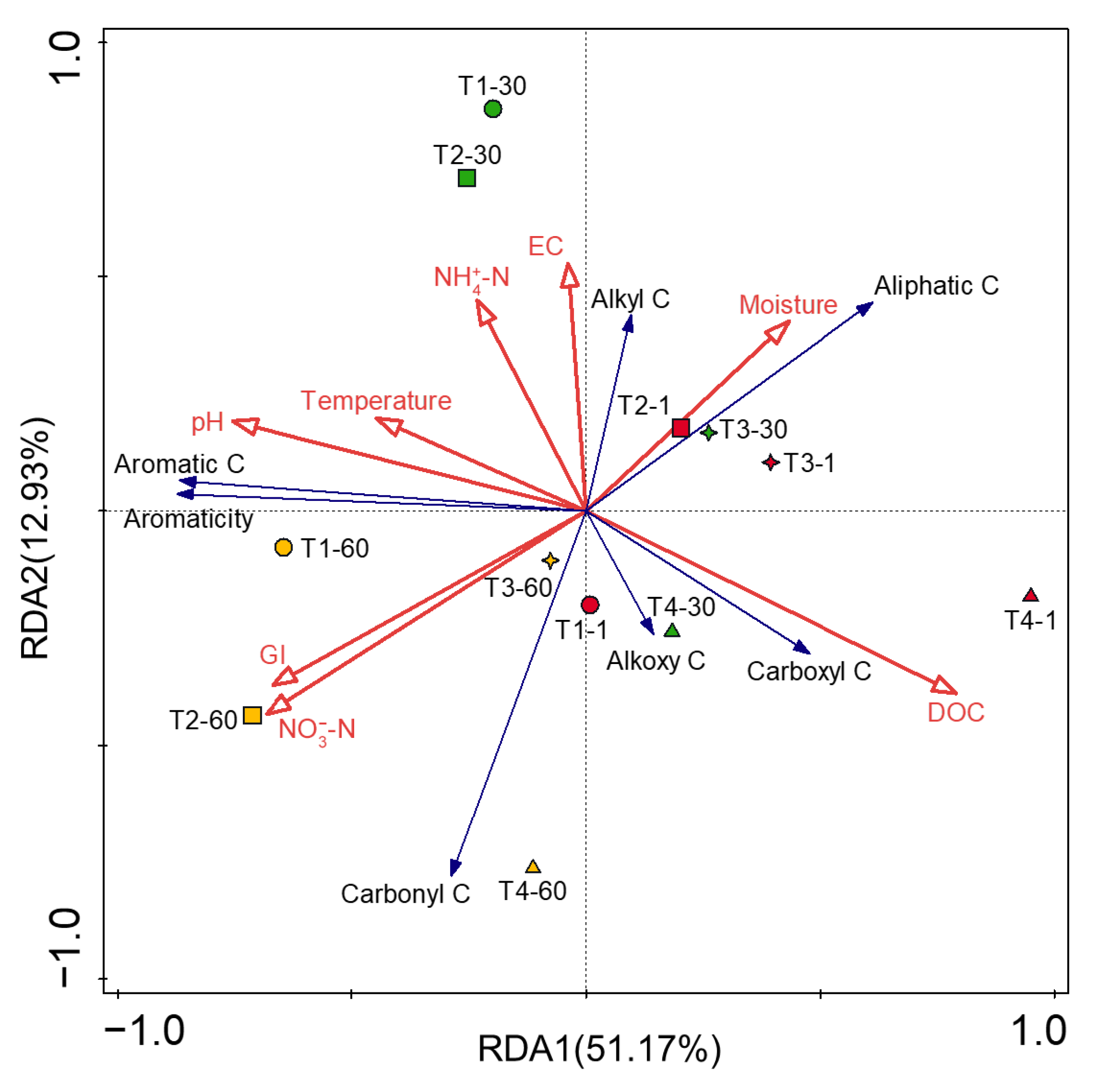Effects of the Ingredients on Maturity and Humification during Kitchen Waste Composting as Illustrated by Nuclear Magnetic Resonance
Abstract
:1. Introduction
2. Materials and Methods
2.1. Composting Materials
2.2. Experimental Design and Implementation
2.3. Sample Collection and Analysis
2.4. Statistical Analysis
3. Results and Discussion
3.1. Changes in Temperature and Moisture Content
3.2. The Evolution of pH and EC
3.3. Pattern of NH4+-N and NO3−-N Contents
3.4. Changes in DOC Contents
3.5. The Germination Index (GI)
3.6. 13C-NMR Spectral Characteristics
3.7. The Relationship between Physicochemical Characteristics and Substance Transformation during Composting
4. Conclusions
Author Contributions
Funding
Institutional Review Board Statement
Informed Consent Statement
Data Availability Statement
Conflicts of Interest
References
- Chavan, S.; Yadav, B.; Tyagi, R.D.; Wong, J.W.C.; Drogui, P. Trends and challenges in the valorization of kitchen waste to polyhydroxyalkanoates. Bioresour. Techonol. 2023, 369, 128323. [Google Scholar] [CrossRef]
- Li, Y.Q.; Jiang, H.; Liu, H.; Luo, S.; Nie, H.; Wang, Y.F.; Qian, M.Y.; Ding, J.T.; Zhou, H.J. Characteristics of kitchen waste and the formation of floating brown particles (FBP) in the anaerobic digestion process. Pol. J. Environ. Stud. 2018, 27, 155–161. [Google Scholar] [CrossRef]
- Xu, Z.C.; Ma, Y.; Zhang, L.X.; Han, Y.Y.; Yuan, J.; Li, G.X.; Luo, W.H. Relating bacterial dynamics and functions to gaseous emissions during composting of kitchen and garden wastes. Sci. Total Environ. 2021, 767, 144210. [Google Scholar] [CrossRef]
- Li, Y.Y.; Jin, Y.Y.; Li, J.H.; Chen, Y.X.; Gong, Y.Y.; Li, Y.Z.; Zhang, J.F. Current situation and development of kitchen waste treatment in China. Procedia Environ. Sci. 2016, 31, 40–49. [Google Scholar] [CrossRef]
- Wang, H.X.; Xu, J.L.; Sheng, L.X. Study on the comprehensive utilization of city kitchen waste as a resource in China. Energy 2019, 173, 263–277. [Google Scholar] [CrossRef]
- Yu, D.Y.; Yu, Y.; Tang, J.W.; Li, X.Q.; Ke, C.; Yao, Z.L. Application fields of kitchen waste biochar and its prospects as catalytic material: A review. Sci. Total Environ. 2022, 810, 152171. [Google Scholar] [CrossRef] [PubMed]
- Ding, Y.; Zhao, J.; Liu, J.W.; Zhou, J.Z.; Cheng, L.; Zhao, J.; Shao, Z.; Iris, Ç.; Pan, B.J.; Li, X.N.; et al. A review of China’s municipal solid waste (MSW) and comparison with international regions: Management and technologies in treatment and resource utilization. J. Clean. Prod. 2021, 293, 126144. [Google Scholar] [CrossRef]
- Tai, J.; Zhang, W.Q.; Che, Y.; Feng, D. Municipal solid waste source-separated collection in China: A comparative analysis. Waste Manag. 2011, 31, 1673–1682. [Google Scholar] [CrossRef] [PubMed]
- Shi, Y.; Deng, Y.W.; Wang, G.A.; Xu, J.P. Stackelberg equilibrium-based eco-economic approach for sustainable development of kitchen waste disposal with subsidy policy: A case study from China. Energy 2020, 196, 117071. [Google Scholar] [CrossRef]
- Kim, J.; Kang, C.M. Increased anaerobic production of methane by co-digestion of sludge with microalgal biomass and food waste leachate. Bioresour. Technol. 2015, 189, 409–412. [Google Scholar] [CrossRef] [PubMed]
- Cao, M.K.; Guo, H.T.; Zheng, G.D.; Chen, T.B.; Cai, L. Microbial succession and degradation during kitchen waste biodrying, highlighting the thermophilic phase. Bioresour. Technol. 2021, 326, 124762. [Google Scholar] [CrossRef] [PubMed]
- Ajay, C.M.; Mohan, S.; Dinesha, P. Decentralized energy from portable biogas digesters using domestic kitchen waste: A review. Waste Manag. 2021, 125, 10–26. [Google Scholar] [CrossRef] [PubMed]
- Vavouraki, A.I.; Volioti, V.; Kornaros, M.E. Optimization of thermo-chemical pretreatment and enzymatic hydrolysis of kitchen wastes. Waste Manag. 2014, 34, 167–173. [Google Scholar] [CrossRef] [PubMed]
- Chen, G.Y.; Wu, G.Y.; Li, N.; Lu, X.K.; Zhao, J.H.; He, M.T.; Yan, B.B.; Zhang, H.Q.; Duan, X.G.; Wang, S.B. Landfill leachate treatment by persulphate related advanced oxidation technologies. J. Hazard. Mater. 2021, 418, 126355. [Google Scholar] [CrossRef]
- Kiran, E.U.; Trzcinski, A.P.; Ng, W.J.; Liu, Y. Bioconversion of food waste to energy: A review. Fuel 2014, 134, 389–399. [Google Scholar] [CrossRef]
- Eleni, I.; Antonis, A.Z. Exploratory research on the adoption of composting for the management of biowaste in the Mediterranean island of Cyprus. Clean. Circ. Bioecon. 2022, 1, 100007. [Google Scholar] [CrossRef]
- Mato, S.; Orto, D.; Garcia, M. Composting of <100 mm fraction of municipal solid waste. Waste Manag. Res. 1994, 12, 315–325. [Google Scholar] [CrossRef]
- Wang, X.J.; Zhang, W.W.; Gu, J.; Gao, H.; Qin, Q.J. Effects of different bulking agents on the maturity, enzymatic activity, and microbial community functional diversity of kitchen waste compost. Environ. Technol. 2016, 37, 2555–2563. [Google Scholar] [CrossRef]
- Ma, J.; Zhang, L.; Mu, L.; Zhu, K.Y.; Li, A.M. Thermally assisted bio-drying of food waste: Synergistic enhancement and energetic evaluation. Waste Manag. 2018, 80, 327–338. [Google Scholar] [CrossRef]
- Xin, L.Q.; Qin, Y.; Lou, T.R.; Xu, X.K.; Wang, H.S.; Mei, Q.Q.; Wu, W.X. Rapid start-up and humification of kitchen waste composting by an innovative biodrying-enhanced process. Chem. Eng. J. 2023, 452, 139459. [Google Scholar] [CrossRef]
- Yang, F.; Li, G.X.; Yang, Q.Y.; Luo, W.H. Effect of bulking agents on maturity and gaseous emissions during kitchen waste composting. Chemosphere 2013, 93, 1393–1399. [Google Scholar] [CrossRef] [PubMed]
- Yang, F.; Li, Y.; Han, Y.H.; Qian, W.T.; Li, G.X.; Luo, W.H. Performance of mature compost to control gaseous emissions in kitchen waste composting. Sci. Total Environ. 2019, 657, 262–269. [Google Scholar] [CrossRef] [PubMed]
- Yang, F.; Li, G.X.; Shi, H.; Wang, Y.M. Effects of phosphogypsum and superphosphate on compost maturity and gaseous emissions during kitchen waste composting. Waste Manag. 2015, 36, 70–76. [Google Scholar] [CrossRef]
- Margaritis, M.; Psarras, K.; Panaretou, V.; Thanos, A.G.; Malamis, D.; Sotiropoulos, A. Improvement of home composting process of food waste using different minerals. Waste Manag. 2018, 73, 87–100. [Google Scholar] [CrossRef]
- Leiva, M.T.G.; Casacuberta, A.A.; Ferrer, A.S. Application of experimental design technique to the optimization of bench-scale composting conditions of municipal raw sludge. Compost Sci. Util. 2003, 11, 321–329. [Google Scholar] [CrossRef]
- Liu, Y.W.; Feng, Y.; Cheng, D.M.; Xue, J.M.; Wakelin, S.A.; Hu, H.Y.; Li, Z.J. Gentamicin degradation and changes in fungal diversity and physicochemical properties during composting of gentamicin production residue. Bioresour. Technol. 2017, 244, 905–912. [Google Scholar] [CrossRef]
- Feng, Y.; Wang, G.Z.; Liu, Y.W.; Cheng, D.M.; Fan, S.H.; Zhao, Q.S.; Xue, J.M.; Zhang, S.Q.; Li, Z.J. The impacts of oxytetracycline on humification during manure composting can be alleviated by initial moisture contents as illustrated by NMR. J. Integr. Agric. 2021, 20, 2277–2288. [Google Scholar] [CrossRef]
- Cheng, D.M.; Feng, Y.; Liu, Y.W.; Xue, J.M.; Li, Z.J. Dynamics of oxytetracycline, sulfamerazine, and ciprofloxacin and related antibiotic resistance genes during swine manure composting. J. Environ. Manag. 2019, 230, 102–109. [Google Scholar] [CrossRef]
- Batham, M.; Arya, R.; Tiwari, A. Time efficient co-composting of water hyacinth and industrial wastes by microbial degradation and subsequent vermicomposting. J. Bioremed. Biodegrad. 2014, 5, 1000222. [Google Scholar] [CrossRef]
- Li, Z.T.; Lu, H.W.; Ren, L.X.; He, L. Experimental and modeling approaches for food waste composting: A review. Chemosphere 2013, 93, 1247–1257. [Google Scholar] [CrossRef]
- Peng, L.J.; Ma, R.N.; Jiang, S.N.; Luo, W.H.; Li, Y.Y.; Wang, G.Y.; Xu, Z.C.; Wang, Y.; Qi, C.R.; Li, Y.M.; et al. Co-composting of kitchen waste with agriculture and forestry residues and characteristics of compost with different particle size: An industrial scale case study. Waste Manag. 2022, 149, 313–322. [Google Scholar] [CrossRef] [PubMed]
- He, Z.H.; Lin, H.; Hao, J.W.; Kong, X.S.; Tian, K.; Bei, Z.L.; Tian, X.J. Impact of vermiculite on ammonia emissions and organic matter decomposition of food waste during composting. Bioresour. Technol. 2018, 263, 548–554. [Google Scholar] [CrossRef]
- Wang, Y.; Zhang, H.; Sun, X. Electrospun nanowebs of NiO/SnO2 p-n heterojunctions for enhanced gas sensing. Appl. Surf. Sci. 2016, 389, 514–520. [Google Scholar] [CrossRef]
- Lin, C. A negative-pressure aeration system for composting food wastes. Bioresour. Technol. 2008, 99, 7651–7656. [Google Scholar] [CrossRef] [PubMed]
- Awasthi, M.K.; Pandey, A.K.; Bundela, P.S.; Khan, J. Co-composting of organic fraction of municipal solid waste mixed with different bulking waste: Characterization of physicochemical parameters and microbial enzymatic dynamic. Bioresour. Technol. 2015, 182, 200–207. [Google Scholar] [CrossRef] [PubMed]
- Hwang, H.Y.; Kim, S.H.; Shim, J.; Park, S.J. Composting Process and Gas Emissions during Food Waste Composting under the Effect of Different Additives. Sustainability 2020, 12, 7811. [Google Scholar] [CrossRef]
- Lü, D.A.; Yan, B.X.; Wang, L.X.; Deng, Z.Q.; Zhang, Y.B. Changes in phosphorus fractions and nitrogen forms during composting of pig manure with rice straw. J. Integr. Agric. 2013, 12, 1855–1864. [Google Scholar] [CrossRef]
- Awasthi, M.K.; Pandey, A.K.; Bundela, P.S.; Wong, J.W.C.; Li, R.H.; Zhang, Z.Q. Co-composting of gelatin industry sludge combined with organic fraction of municipal solid waste and poultry waste employing zeolite mixed with enriched nitrifying bacterial consortium. Bioresour. Technol. 2016, 213, 181–189. [Google Scholar] [CrossRef] [PubMed]
- Li, R.H.; Wang, J.J.; Zhang, Z.Q.; Shen, F.; Zhang, G.J.; Qin, R.; Li, X.L.; Xiao, R. Nutrient transformations during composting of pig manure with bentonite. Bioresour. Technol. 2012, 121, 362–368. [Google Scholar] [CrossRef]
- Awasthi, M.K.; Wang, Q.; Huang, H.; Ren, X.N.; Lahori, A.H.; Mahar, A.; Ali, A.; Shen, F.; Li, R.H.; Zhang, Z.Q. Influence of zeolite and lime as additives on greenhouse gas emissions and maturity evolution during sewage sludge composting. Bioresour. Technol. 2016, 216, 172–181. [Google Scholar] [CrossRef]
- Wang, Q.; Wang, Z.; Awasthi, M.K.; Jiang, Y.H.; Li, R.H.; Ren, X.N.; Zhao, J.C.; Shen, F.; Wang, M.J.; Zhang, Z.Q. Evaluation of medical stone amendment for the reduction of nitrogen loss and bioavailability of heavy metals during pig manure composting. Bioresour. Technol. 2016, 220, 297–304. [Google Scholar] [CrossRef] [PubMed]
- Liu, N.; Hou, T.; Yin, H.J.; Han, L.J.; Huang, G.Q. Effects of amoxicillin on nitrogen transformation and bacterial community succession during aerobic composting. J. Hazard. Mater. 2019, 362, 258–265. [Google Scholar] [CrossRef]
- Nakhshiniev, B.; Biddinika, M.K.; Gonzales, H.B.; Sumida, H.; Yoshikawa, K. Evaluation of hydrothermal treatment in enhancing rice straw compost stability and maturity. Bioresour. Technol. 2014, 151, 306–313. [Google Scholar] [CrossRef]
- Tiquia, S.M.; Tam, N.F. Characterization and composting of poultry litter in forced-aeration piles. Process Biochem. 2002, 37, 869–880. [Google Scholar] [CrossRef]
- Jiang, J.S.; Liu, X.L.; Huang, Y.M.; Hua, H. Inoculation with nitrogen turnover bacterial agent appropriately increasing nitrogen and promoting maturity in pig manure composting. Waste Manag. 2015, 39, 78–85. [Google Scholar] [CrossRef] [PubMed]
- Cáceres, R.; Malińska, K.; Marfà, O. Nitrification within composting: A review. Waste Manag. 2018, 72, 119–137. [Google Scholar] [CrossRef]
- Chang, J.I.; Tsai, J.J.; Wu, K.H. Thermophilic composting of food waste. Bioresour. Technol. 2006, 97, 116–122. [Google Scholar] [CrossRef]
- Iannotti, D.A.; Grebus, M.E.; Toth, B.L.; Madden, L.V.; Hoitink, H.A.J. Oxygen respirometry to assess stability and maturity of composted municipal solid waste. J. Environ. Qual. 1994, 23, 1177–1183. [Google Scholar] [CrossRef]
- Zhou, Y.; Selvam, A.; Wong, J.W. Evaluation of humic substances during co-composting of food waste, sawdust and Chinese medicinal herbal residues. Bioresour. Technol. 2014, 168, 229–234. [Google Scholar] [CrossRef]
- Guo, R.; Li, G.X.; Jiang, T.; Schuchardt, F.; Chen, T.B.; Zhao, Y.Q.; Shen, Y.J. Effect of aeration rate, C/N ratio and moisture content on the stability and maturity of compost. Bioresour. Technol. 2012, 112, 171–178. [Google Scholar] [CrossRef]
- Fang, M.; Wong, J.W.C.; Ma, K.K.; Wong, M.H. Co-composting of sewage sludge and coal fly ash: Nutrient transformations. Bioresour. Technol. 1999, 67, 19–24. [Google Scholar] [CrossRef]
- Zhao, J.; Wang, D.; Liu, Y.; Ngo, H.H.; Li, X. Novel stepwise pH control strategy to improve short chain fatty acid production from sludge anaerobic fermentation. Bioresour. Technol. 2018, 249, 431–438. [Google Scholar] [CrossRef] [PubMed]
- Amir, S.; Hafidi, M.; Merlina, G.; Hamdi, H.; Revel, J.C. Elemental analysis, FTIR and 13C-NMR of humic acidsfom sewage sludge composting. Agronomie 2004, 24, 13–18. [Google Scholar] [CrossRef]
- Amir, S.; Jouraiphy, A.; Meddich, A.; Gharous, M.E.; Hafidi, M. Structural study of humic acids during composting of activated sludge-green waste: Elemental analysis, FTIR and 13C NMR. J. Hazard. Mater. 2010, 177, 524–529. [Google Scholar] [CrossRef] [PubMed]
- Chefetz, B.; Hader, Y.; Chen, Y. Dissolved organic carbon fractions formed during composting of municipal solid waste: Properties and significance. Acta Hydrochim. Hydrobiol. 1998, 26, 172–179. [Google Scholar] [CrossRef]
- Almendros, G.; Dorado, J.; González-Vila, F.M.; Blanco, M.J.; Lankes, U. 13C NMR assessment of decomposition patterns during composting of forest and shrub biomass. Soil Biol. Biochem. 2000, 32, 793–804. [Google Scholar] [CrossRef]
- Pacchiano, J.R.A.; Sohn, W.; Chlanda, V.L.; Garbow, J.R.; Stark, R.E. Isolation and spectral characterization of plant-cuticle polyesters. J. Agric. Food Chem. 1993, 41, 78–83. [Google Scholar] [CrossRef]
- Hu, Y.; Kobayashi, T.; Qi, W.; Oshibe, H.; Xu, K.Q. Effect of temperature and organic loading rate on siphon-driven self-agitated anaerobic digestion performance for food waste treatment. Waste Manag. 2018, 74, 150–157. [Google Scholar] [CrossRef]
- Kolodziejski, W.; Frye, J.S.; Maciel, G.E. Carbon-13 nuclear magnetic resonance spectrometry with cross polarization and magic-angle spinning for analysis of lodgepole pine wood. Anal. Chem. 1982, 54, 1419–1424. [Google Scholar] [CrossRef]
- Sachs, S.; Bubner, M.; Schmeide, K.; Choppin, G.R.; Heise, K.H.; Bernhard, G. Carbon-13 NMR spectroscopic studies on chemically modified and unmodified synthetic and natural humic acids. Talanta 2002, 57, 999–1009. [Google Scholar] [CrossRef]
- Jindo, K.; Martim, S.A.; Navarro, E.C.; Pérez-Alfocea, F.; Hernandez, T.; Garcia, C.; Aguiar, N.O.; Canellas, L.P. Root growth promotion by humic acids from composted and non-composted urban organic wastes. Plant Soil 2012, 353, 209–220. [Google Scholar] [CrossRef]
- Bernal, M.P.; Alburquerque, J.A.; Moral, R. Composting of animal manures and chemical criteria for compost maturity assessment. A review. Bioresour. Technol. 2009, 100, 5444–5453. [Google Scholar] [CrossRef] [PubMed]
- Castaldi, P.; Alberti, G.; Merella, R.; Melis, P. Study of the organic matter evolution during municipal solid waste composting aimed at identifying suitable parameters for the evaluation of compost maturity. Waste Manag. 2005, 25, 209–213. [Google Scholar] [CrossRef]
- Jouraiphy, A.; Amir, S.; Winterton, P.; Gharous, M.E.; Revel, J.C.; Hafidi, M. Structural study of the fulvic fraction during composting of activated sludge-plant matter: Elemental analysis, FTIR and 13C NMR. Bioresour. Technol. 2008, 99, 1066–1072. [Google Scholar] [CrossRef]
- Amir, S.; Hafidi, M.; Merlina, G.; Revel, J.C. Structural characterization of fulvic acids during composting of sewage sludge. Process Biochem. 2005, 40, 1693–1700. [Google Scholar] [CrossRef]







| Composting Materials | pH | MC (%) | TOC (%) | TN (%) | C/N |
|---|---|---|---|---|---|
| Kitchen waste | 4.38 | 79.12 | 47.68 | 2.51 | 18.99 |
| Corn straw | 7.68 | 8.40 | 45.11 | 0.85 | 53.07 |
| Garden waste | 5.85 | 21.13 | 54.25 | 2.01 | 26.99 |
| Signal (ppm) | Attributed Chemical Components * |
|---|---|
| 0–50 | Paraffinic carbons in alkyl chains |
| 50–110 | Aliphatic carbons substituted by oxygen and nitrogen |
| 110–130 | Olefinic carbons; unsubstituted aromatic carbons |
| 130–145 | Carbon-substituted aromatic carbons |
| 145–160 | Oxygen or nitrogen substituted aromatic carbons |
| 160–190 | Carboxyl carbons, ester or amide carbons |
| 190–215 | Carbonyl carbons |
| Treatments | Time | Alkyl C | Alkoxy C | Aliphatic C | Aromatic C | Carboxyl C | Carbonyl C | Aromaticity 1 (%) |
|---|---|---|---|---|---|---|---|---|
| 0–50 ppm | 50–110 ppm | 0–110 ppm | 110–160 ppm | 160–190 ppm | 190–220 ppm | |||
| T1 | day 0 | 19.83 | 64.37 | 84.20 | 5.74 | 7.88 | 2.21 | 6.38 |
| day 30 | 23.45 | 59.58 | 83.03 | 9.04 | 6.48 | 1.45 | 9.82 | |
| day 60 | 19.83 | 63.04 | 82.87 | 8.22 | 7.25 | 1.66 | 9.02 | |
| T2 | day 0 | 18.46 | 67.95 | 86.41 | 6.75 | 5.69 | 1.16 | 7.25 |
| day 30 | 32.71 | 52.72 | 85.43 | 5.51 | 8.26 | 0.79 | 6.06 | |
| day 60 | 23.05 | 58.62 | 81.67 | 8.40 | 7.60 | 2.33 | 9.33 | |
| T3 | day 0 | 29.88 | 53.78 | 83.66 | 3.55 | 11.06 | 1.74 | 4.07 |
| day 30 | 25.12 | 59.00 | 84.12 | 5.24 | 9.33 | 1.32 | 5.86 | |
| day 60 | 28.30 | 54.40 | 82.70 | 5.78 | 9.37 | 2.16 | 6.53 | |
| T4 | day 0 | 23.95 | 62.39 | 86.34 | 2.42 | 9.98 | 1.24 | 2.73 |
| day 30 | 20.00 | 64.46 | 84.46 | 4.93 | 8.81 | 1.81 | 5.52 | |
| day 60 | 21.36 | 59.20 | 80.56 | 7.50 | 8.84 | 3.11 | 8.52 |
Disclaimer/Publisher’s Note: The statements, opinions and data contained in all publications are solely those of the individual author(s) and contributor(s) and not of MDPI and/or the editor(s). MDPI and/or the editor(s) disclaim responsibility for any injury to people or property resulting from any ideas, methods, instructions or products referred to in the content. |
© 2023 by the authors. Licensee MDPI, Basel, Switzerland. This article is an open access article distributed under the terms and conditions of the Creative Commons Attribution (CC BY) license (https://creativecommons.org/licenses/by/4.0/).
Share and Cite
Feng, Y.; Li, Z.; Liu, C.; Yan, T.; Shi, H.; Yang, R. Effects of the Ingredients on Maturity and Humification during Kitchen Waste Composting as Illustrated by Nuclear Magnetic Resonance. Sustainability 2023, 15, 13436. https://doi.org/10.3390/su151813436
Feng Y, Li Z, Liu C, Yan T, Shi H, Yang R. Effects of the Ingredients on Maturity and Humification during Kitchen Waste Composting as Illustrated by Nuclear Magnetic Resonance. Sustainability. 2023; 15(18):13436. https://doi.org/10.3390/su151813436
Chicago/Turabian StyleFeng, Yao, Zhaojun Li, Chenfeng Liu, Tiezhu Yan, Huading Shi, and Rongjin Yang. 2023. "Effects of the Ingredients on Maturity and Humification during Kitchen Waste Composting as Illustrated by Nuclear Magnetic Resonance" Sustainability 15, no. 18: 13436. https://doi.org/10.3390/su151813436
APA StyleFeng, Y., Li, Z., Liu, C., Yan, T., Shi, H., & Yang, R. (2023). Effects of the Ingredients on Maturity and Humification during Kitchen Waste Composting as Illustrated by Nuclear Magnetic Resonance. Sustainability, 15(18), 13436. https://doi.org/10.3390/su151813436








